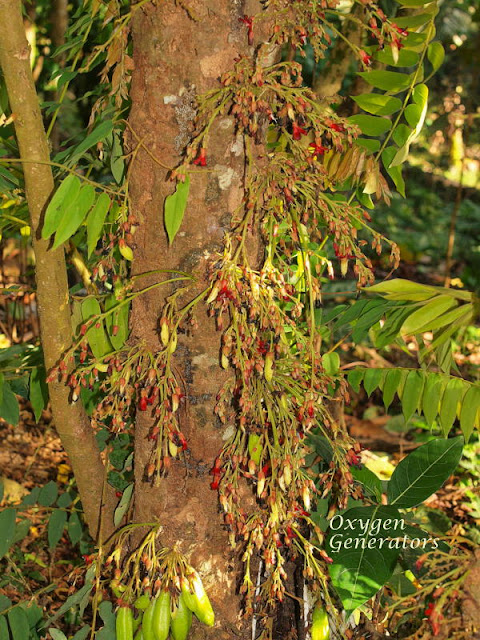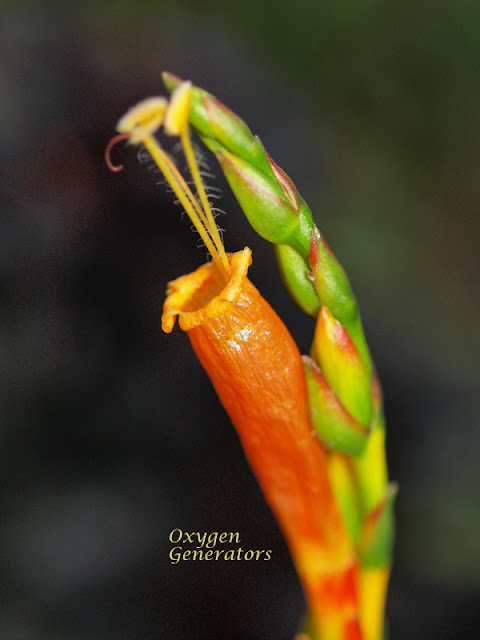Dry season is here, the many symptoms are already evident aside from the heat. Plants have unusual responses to this change in environmental conditions. Deciduous trees decide to shed their leaves during this time, but this is exhibited by mostly forest trees. Others show the almost autumnal colors. There are also trees that decide to flower at the onset of the dry season, and there are those producing very vigorous flushes or nicely colored shoot growths.
avocado flowers, Persea americana
In July to August, we will again have a lot of avocado fruits, and sometimes we have the problem of disposal. When the single assembler-wholesaler in our area died, nobody seems to be interested again to act as middleman in disposing fruits from small producers. On the other hand, our family cannot eat all our produce.
mango flowers, Mangifera indica
Mango flowers extensively too. However, we don't get many fruits normally due to pests and diseases. Commercial growers individually wrap fruits, which we cannot do ourselves. Insects are very happy with our area as they can eat as much as they want. It is both advantageous and disadvantageous though.
kamyas, kalamyas flowers and fruits (Averrhoa bilimbi)
Fruits of this plant are traditionally and culturally intertwined with our food preparations. We use this as souring agent for meat and fish, and the mature fruits are dried, pickled or made into sweets.
Averrhoa bilimbi flower in detail
Flowers are small, only about two centimeters in diameter if they are open. Bees and insects love the nectar and help them be pollinated.
We also have the red pentas but they don't have good blooms when this photo was taken. You will notice the reclining stems of both the pentas and the coleus, that is because the chickens love to rest on them. They probably love the colder temperatures while resting there. At least they don't pick on the leaves. These are directly planted on the ground.
Chrysothemis pulchelia has tubers or enlarged basal portion of the stem, when there is not enough water, they stay dormant and shoot again upon watering. Sometimes, the extreme heat kill these tubers but somehow during the following rainy season, a lot of shoots will emerge again somewhere. Their seeds probably manage to remain alive in the soil.
Dracaena surcolosa
Dracaena surcolosa flowers
This is also called Florida beauty, one of the most resistant plants to neglect and drought. This is actually planted on a very thin topsoil, but it still grows luxuriantly and doesn't stop flowering. Those lantern-like blooms eventually turn into very red berries when ripened. The Chinese love this plant and considered very auspicious.
Clerodendrum speciossisimum
Clerodendrum speciossisimum
This bushy plant is considered a weed in our area. But i allow some of them to thrive because butterflies and bees love its flowers. An advantage of this is the ability to flower and bloom even without any care given, as long as they are planted directly on the ground. Its roots are deep allowing them to grow in the dry season.
Heliconia rostrata
Sanchezia speciosa



Blooms of this heliconia starts in February and stay beautifully colorful throughout the dry season. When other blooms succumb to the hot temperatures without water, their blooms flourish and stay as food for insects for more than 2 months.
Sanchezia speciosa blooms in Feb to March, but I don't like too much blooms. Sometimes i pinch them while still very young to preserve the beauty of their striped foliage. At the start of the rainy season, the plants will be pruned extensively to change the whole growth.















Such beautiful and varied flowers in both your seasons...
ReplyDeleteYes Donna that is correct, although many of the flowers are present in both seasons.
DeleteWell I know where to come when I need knowledge on flowers...goodness. All I know is that they are so beautiful and I can't quit shooting them. LOL!
ReplyDeletehahaha yes I am like that, i can't quit shooting even if I've done it a lot of times in the past. But i miss the blues which we just have a few.
DeleteVery beautiful blooms.
ReplyDeleteThanks for visiting Rajesh.
Deletebeautiful flowers and photo's. I can learn a lot here every day
ReplyDeleteYes Riet, blogging let us learn from gardeners of different climates.
DeleteWow, so many beautiful and (to me) exotic flowers! I am blown away by the Clerodendrum and Heliconia. Hard to imagine a place where there are more mangos and avocados than people can eat! Sounds like the perfect place for me, if it weren't so hot.
ReplyDeleteYes Jason, if only it is not too hot, it really is paradise! So i am begging the temperate climates to please send us some cold breeze and please have it sustained longer!
DeleteI missed all of these tropics plants from our country.. I have some as well in my garden but its different when you actually see them growing in your own land. I love your photos always.
ReplyDeleteThanks, enjoy the rest of the week, Its too hot here in Phnom penh !
Hi Elma, thank you. I was there at the height of the dry season and i agree with you, it is really hot. Siem Reap is better because of the trees.
DeleteAndrea, I applied that method of wrapping the fruits to my friend's dwarf avocado tree. I used old newspapers, and it worked. The crows stopped picking on the fruit.
ReplyDeleteP.S. When you come and visit, I will take you wherever I go. That's a promise.
Wrapping mangoes keeps them clean of insect bites, but wrapping lansones fruits wont deter the bats, they know how to unwrap them! Thanks for the offer, but might not be possible at all unless some miracle happens!
DeleteBeautiful plants! You've a great knowledge of what you grow! I remember when my brother's mango tree (He lived in Philippines for 11 years) had nests of Fire ants up in the leaves. I was fed up watching them trying to chop the branches down and thought I would attempt it myself....not a good idea - they are very painful when they bite!! In the end I resorted to paying the estate gardeners a few Peso to deal with them!
ReplyDeleteOh it is a waste to cut the branches with ants, you just need a good pest control officer who knows what kills ants, or what drive them away. Spray with diluted soap might even work, or just plain disturbance!
DeleteKalantikan - the tree was covered in them - you know how they make those huge nests with the leaves nothing was working - they had been trying for 2 weeks before I got there - the garden was a sea of these little red blighters!
DeleteThe plants that you have shown are also as ubiquitous here in Malaysia. I like your photo of the Clerodendrum speciossisimum. I have taken some photos before and they look so messy.
ReplyDeleteWhat do you mean about Clerodendrum being so messy? I just know this plant or weed in our property has unfavorable leaf odor when touched. I actually don't want to come near this, haha!
DeleteI like the plant with its pyramidal inflorescence which is so majestic. What I actually meant was how they appeared in my photos. I used a macro with shallow DOF, so some of the florets were in focused while others were not.
DeleteThe pyramidal shape inflorescence is i think of a different species. That one and ours has different leaf shapes, flower colors and spike form. It is C.paniculatum.
DeleteThe Clerodendrum speciossisimum image is so beautiful Andrea. The plant is too! I saw a lot of Heliconia in St. Lucia and that was such a treat. Nothing like that plant here.
ReplyDeleteIt is wonderful to see all your beautiful color, Andrea. A feast for the eyes, for sure.
ReplyDeleteWow - your blooms look very exotic to me - it's great to see a garden in such a different area from mine - central coast of California, wild native garden - I enjoyed my peek at your flowers and enjoyed your insights. I like to think of the chickens resting on the cool leaves!
ReplyDelete